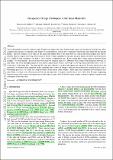| dc.contributor.author | Polishook, David | |
| dc.contributor.author | Moskovitz, Nicholas | |
| dc.contributor.author | Carry, Benoit | |
| dc.contributor.author | DeMeo, Francesca E | |
| dc.contributor.author | Binzel, Richard P | |
| dc.date.accessioned | 2016-04-04T23:44:08Z | |
| dc.date.available | 2016-04-04T23:44:08Z | |
| dc.date.issued | 2013-11 | |
| dc.date.submitted | 2013-11 | |
| dc.identifier.issn | 00191035 | |
| dc.identifier.issn | 1090-2643 | |
| dc.identifier.uri | http://hdl.handle.net/1721.1/102162 | |
| dc.description.abstract | Very red featureless asteroids (spectroscopic D-types) are expected to have formed in the outer Solar System far from the Sun. They comprise the majority of asteroids in the Jupiter Trojan population, and are also commonly found in the outer main belt and among Hildas. The first evidence for D-types in the inner and middle parts of the main belt was seen in the Sloan Digital Sky Survey (SDSS). Here we report follow-up observations of SDSS D-type candidates in the near-infrared. Based on follow up observations of 13 SDSS D-type candidates, we find a ∼20% positive confirmation rate. Known inner belt D-types range in diameter from roughly 7 to 30 km. Based on these detections we estimate there are ∼100 inner belt D-types with diameters between 2.5 and 20 km. The lower and upper limits for total mass of inner belt D-types is 2 × 10[superscript 16] kg to 2 × 10[superscript 17] kg which represents 0.01–0.1% of the mass of the inner belt. The inner belt D-types have albedos at or above the upper end typical for D-types which raises the question as to whether these inner belt bodies represent only a subset of D-types, they have been altered by external factors such as weathering processes, or if they are compositionally distinct from other D-types. All D-types and candidates have diameters less than 30 km, yet there is no obvious parent body in the inner belt. Dynamical models have yet to show how D-types originating from the outer Solar System could penetrate into the inner reaches of the main belt under current scenarios of planet formation and subsequent Yarkovsky drift. | en_US |
| dc.language.iso | en_US | |
| dc.publisher | Elsevier | en_US |
| dc.relation.isversionof | http://dx.doi.org/10.1016/j.icarus.2013.11.026 | en_US |
| dc.rights | Creative Commons Attribution-Noncommercial-NoDerivatives | en_US |
| dc.rights.uri | http://creativecommons.org/licenses/by-nc-nd/4.0/ | en_US |
| dc.source | Arxiv | en_US |
| dc.title | Unexpected D-type interlopers in the inner main belt | en_US |
| dc.type | Article | en_US |
| dc.identifier.citation | DeMeo, Francesca E., Richard P. Binzel, Benoıˆt Carry, David Polishook, and Nicholas A. Moskovitz. “Unexpected D-Type Interlopers in the Inner Main Belt.” Icarus 229 (February 2014): 392–399. | en_US |
| dc.contributor.department | Massachusetts Institute of Technology. Department of Earth, Atmospheric, and Planetary Sciences | en_US |
| dc.contributor.mitauthor | DeMeo, Francesca E. | en_US |
| dc.contributor.mitauthor | Binzel, Richard P. | en_US |
| dc.contributor.mitauthor | Polishook, David | en_US |
| dc.contributor.mitauthor | Moskovitz, Nicholas | en_US |
| dc.relation.journal | Icarus | en_US |
| dc.eprint.version | Author's final manuscript | en_US |
| dc.type.uri | http://purl.org/eprint/type/JournalArticle | en_US |
| eprint.status | http://purl.org/eprint/status/PeerReviewed | en_US |
| dspace.orderedauthors | DeMeo, Francesca E.; Binzel, Richard P.; Carry, Benoıˆt; Polishook, David; Moskovitz, Nicholas A. | en_US |
| mit.license | PUBLISHER_CC | en_US |
